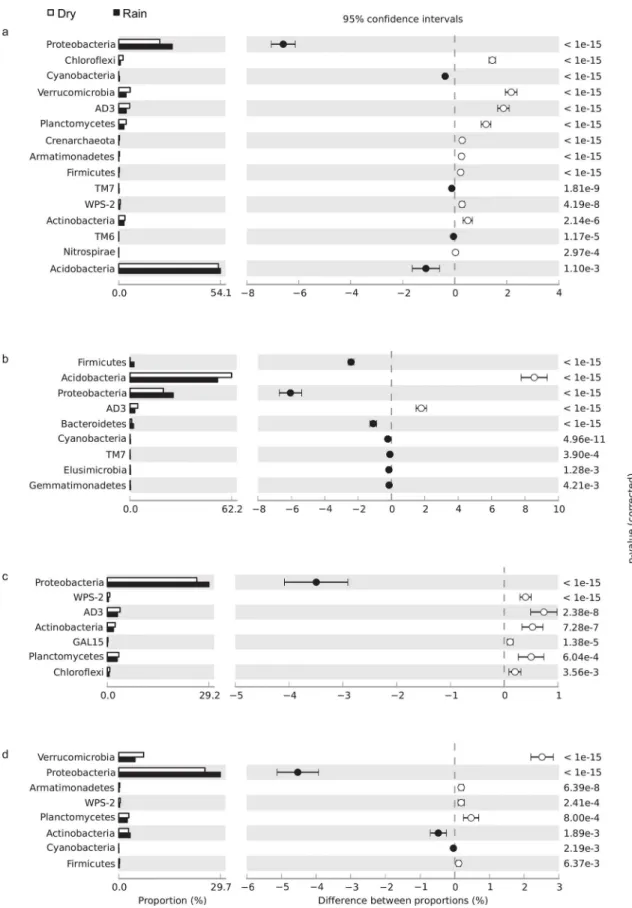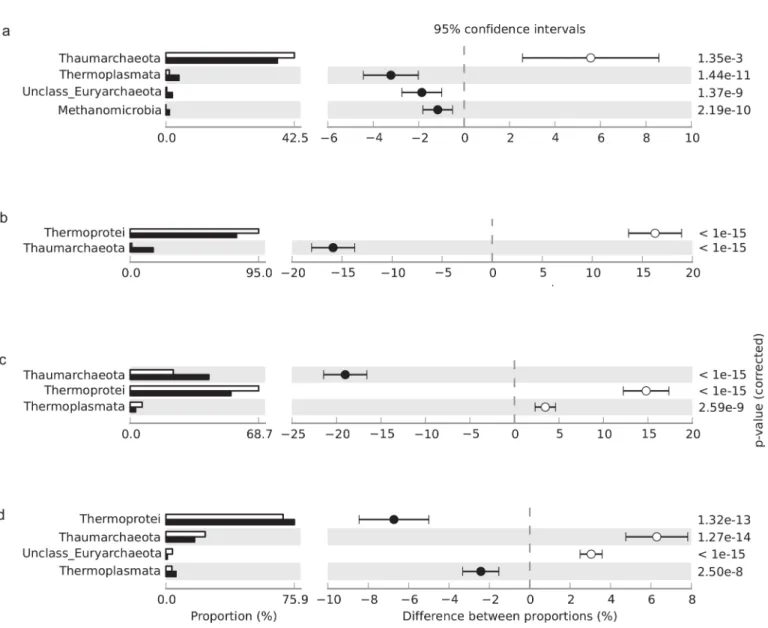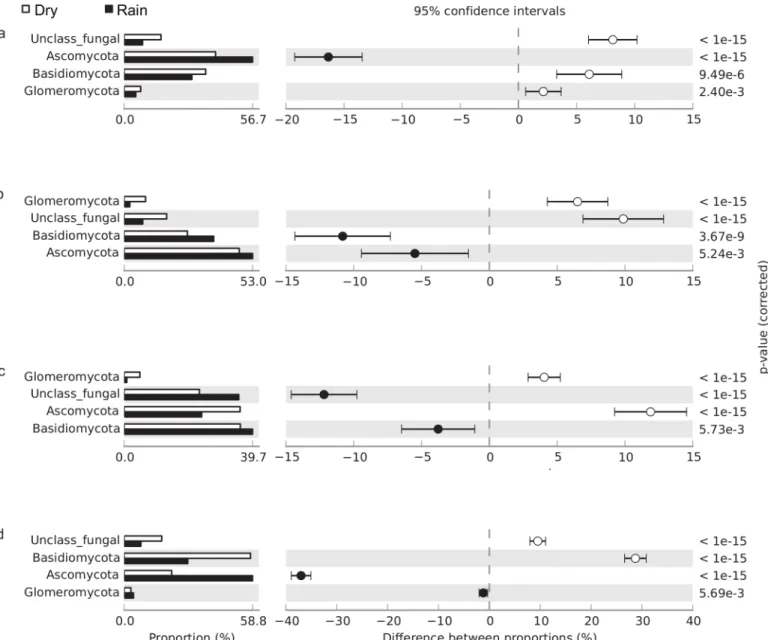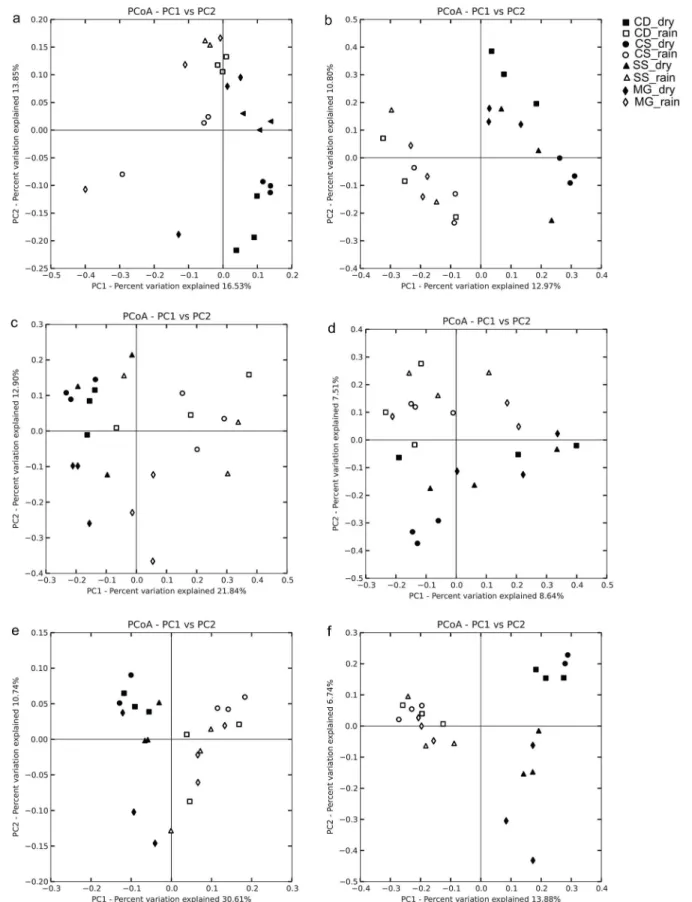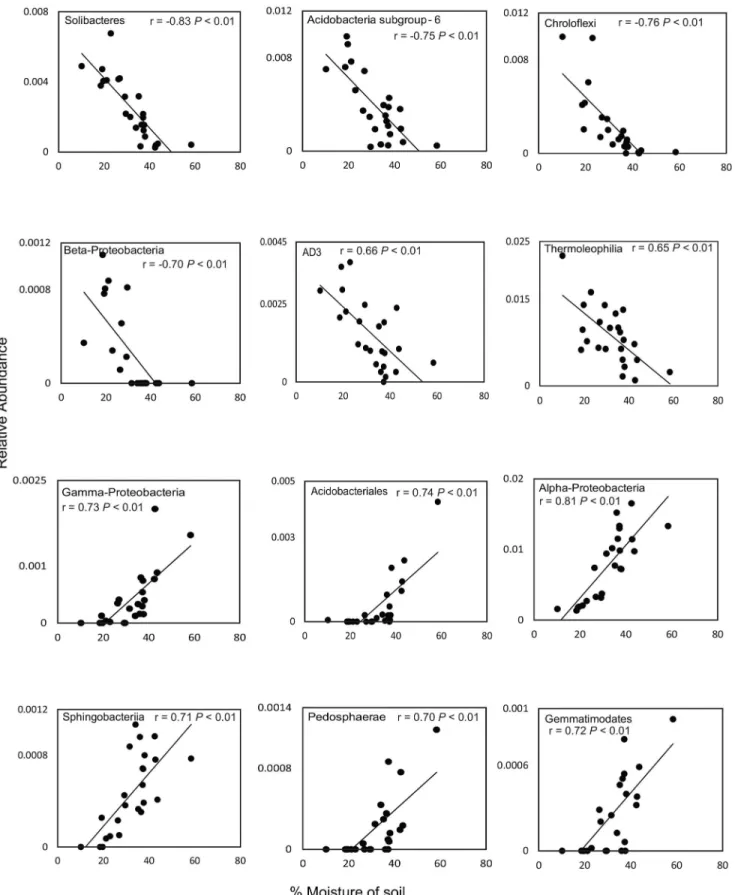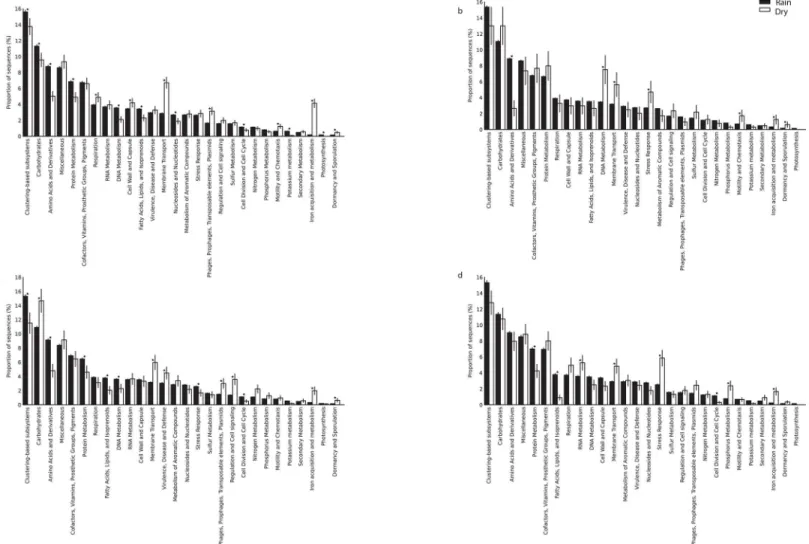Microbial Diversity in Cerrado Biome
(Neotropical Savanna) Soils
Alinne Pereira de Castro1,2, Maria Regina Silveira Sartori da Silva3, Betania
Ferraz Quirino4,5, Mercedes Maria da Cunha Bustamante3, Ricardo Henrique Krüger1*
1Enzymology Laboratory, Departamento de Biologia Celular, Universidade de Brasilia, Brasília, DF, Brazil, 2Universidade Católica Dom Bosco, Biotechnology Program, Campo Grande, MS, Brazil,3Laboratório de Ecologia de Ecossistemas, Departamento de Ecologia, Instituto de Ciências Biológicas, Universidade de
Brasília, Brasília, DF, Brazil,4Embrapa-Agroenergy, Brasília, DF, Brazil,5Genomic Sciences and Biotechnology Program, Universidade Católica de Brasília, Brasília, DF, Brazil
*kruger@unb.br
Abstract
The Cerrado, the largest savanna region in South America, is located in central Brazil. Cer-rado physiognomies, which range from savanna grasslands to forest formations, combined with the highly weathered, acidic clay Cerrado soils form a unique ecoregion. In this study, high-throughput sequencing of ribosomal RNA genes was combined with shotgun metage-nomic analysis to explore the taxometage-nomic composition and potential functions of soil micro-bial communities in four different vegetation physiognomies during both dry and rainy seasons. Our results showed that changes in bacterial, archaeal, and fungal community structures incerrado denso, cerradosensu stricto,campo sujo, and gallery forest soils strongly correlated with seasonal patterns of soil water uptake. The relative abundance of AD3, WPS-2, Planctomycetes, Thermoprotei, and Glomeromycota typically decreased in the rainy season, whereas the relative abundance of Proteobacteria and Ascomycota increased. In addition, analysis of shotgun metagenomic data revealed a significant increase in the relative abundance of genes associated with iron acquisition and metabo-lism, dormancy, and sporulation during the dry season, and an increase in the relative abun-dance of genes related to respiration and DNA and protein metabolism during the rainy season. These gene functional categories are associated with adaptation to water stress. Our results further the understanding of how tropical savanna soil microbial communities may be influenced by vegetation covering and temporal variations in soil moisture.
Introduction
Despite the considerable biodiversity found in Brazil, only recently have efforts been made to describe microbial diversity in the different Brazilian biomes. To better understand patterns of microbial distribution, an initiative has brought together leading microbial diversity studies conducted in various Brazilian biomes during the last 5 years [1], which has provided the infor-mation needed forin silicoanalysis of 16S ribosomal RNA (rRNA) genes. Previous studies have shown that some Brazilian soils support more complex microbial communities than OPEN ACCESS
Citation:Pereira de Castro A, Sartori da Silva MRS, Quirino BF, da Cunha Bustamante MM, Krüger RH (2016) Microbial Diversity in Cerrado Biome (Neotropical Savanna) Soils. PLoS ONE 11(2): e0148785. doi:10.1371/journal.pone.0148785
Editor:Fabiano L. Thompson, Universidade Federal do Rio de Janeiro, BRAZIL
Received:July 30, 2015
Accepted:January 22, 2016
Published:February 5, 2016
Copyright:© 2016 Pereira de Castro et al. This is an open access article distributed under the terms of the
Creative Commons Attribution License, which permits unrestricted use, distribution, and reproduction in any medium, provided the original author and source are credited.
Data Availability Statement:The 454 FLX Titanium flowgrams (sff files) have been submitted to the National Center for Biotechnology Information (NCBI) Sequence Read Archive database, project number: PRJNA298258.
others, with an unexplored genetic diversity [2–5]. The soils of the Cerrado biome have been the principal focus of a number of culture-independent analyses of microbial diversity [2,6–8].
The Cerrado, which is considered the largest savanna region in South America, is located in the central Brazil, bordered by Amazonian forests to the northwest and the Atlantic coastal for-est to the southeast [9]. The Cerrado biome is thought to have existed even before the final sep-aration of the South American and African continents. Its physiognomies, which vary from savanna grasslands to forest formations, in combination with its soil conditions (weathered, acidic, with high clay content) form a unique ecoregion [9]. The Cerrado biome offers a home to a wide range of plants, animals, and microorganisms, making it one of the 25 most vital ter-restrial biodiversity hotspots described by Myers et al. [10]. However, its true diversity is unclear, as estimates vary considerably among studies. Despite its importance, the cerrado biome has suffered degradation for decades due to human activity and land use changes. The most drastic impact to the biome was the construction of the new capital Brasília in 1960 in the center of the Brazilian Cerrado and the subsequent 50-fold increase in population in this region.
Although many studies have shown that alterations in environmental conditions are impor-tant drivers of changes in soil microbial diversity, this has been poorly documented in the Cer-rado biome. In particular, detailed studies are needed to understand how soil microbial community structure and function in the Cerrado vary across terrestrial environments, and how soil microbial communities are influenced by the temporal variations in soil moisture associated with vegetation cover. For this reason, this study investigated the bacterial, archaeal, and fungal associations in Cerrado soils within four different vegetation physiognomies using high-throughput DNA sequencing of ribosomal marker sequences in combination with shot-gun metagenomic analysis. Revealing diversity at the genetic level will be fundamental to fur-thering our current understanding of microbial interactions and the potential consequences of future climate change in terrestrial ecosystems.
Material and Methods
Sample collection
The study site was located in the Brazilian Institute of Geography and Statistics (IBGE) Eco-logical Reserve, a protected area in the Federal District of Brazil. Soil samples were obtained from four different vegetation physiognomies:cerrado denso(dense tree layer ranging from 5 to 8 m in height) (15° 56' 43.1''S, 47° 51' 26.0''W), cerradosensu stricto(continuous grass layer and a woody layer of trees and shrubs varying in cover between 10% and 60%) (15° 57' 02.4''S, 47° 5' 32.1''W),campo sujo(open savanna with widely scattered small trees and shrubs) (15° 56' 54.6''S, 47° 52' 11.7''W), and gallery forest (forest formation along a water course) (15° 57' 06.0''S, 47° 53' 18.7''W).
Soil sampling methods and physicochemical analyses of these habitats were previously described [2]. In the dry season (September 2010) and rainy season (February 2011), three rep-licate soil samples were obtained from each of the four vegetation physiognomies (24 samples total). Gravimetric water content was calculated based on soil weight before and after the sam-ples were oven-dried at 105°C for 72 h. Physicochemical properties of the soils were deter-mined using samples obtained in the dry season (S1 Table).
High-throughput DNA sequencing of ribosomal RNA genes
Microbial DNA was extracted from 0.5 g soil from each of the 24 samples using the PowerSoil DNA Isolation Kit (MO BIO Laboratories, Carlsbad, CA, USA) according to the manufactur-er’s instructions. The triplicate DNA samples were not pooled.
Bacterial 16S rRNA genes were amplified with the primer pair 787F/1492R [11], archaeal 16S rRNA genes were amplified with the primer pair 751F/UA1406R [12], and fungal 18S rRNA genes were amplified with the primer pair EF4F/Fung5R [13] using a previously described polymerase chain reaction (PCR) protocol [2]. The amplicons were purified using the QIAquick PCR Purification Kit (QIAGEN, Chatsworth, CA) and sequenced using the GS FLX+ Titanium system (454 Life Sciences Corporation, Branford, CT, USA).
rRNA gene analysis
The rRNA gene analyses were performed using Quantitative Insights Into Microbial Ecology (QIIME) software, version 1.6.0-dev [14]. Briefly, adaptor sequences were trimmed from raw data, with 98% or more of the bases demonstrating a Phred quality score of 30. Sequences were binned into individual sample collections based on barcode sequence tags, which were then trimmed. The resulting files were denoised using the PyroNoise algorithm. Sequences less than 180 bp in length were deleted, and the rest were clustered into species-level operational taxo-nomic units (OTUs) at 97% sequence similarity using an open-reference OTU picking proto-col. Taxonomic assignment was carried out by alignment with the Greengenes database using the Uclust algorithm.
The alpha and beta diversity of the microbial communities were determined. Significant dif-ferences between groups were evaluated by analysis of similarities (ANOSIM) [15], and the partial Mantel test was used to evaluate relationships between level of precipitation and micro-bial community composition. Groups were compared by Fisher’s exact test (confidence inter-vals with nominal coverage of 95%), followed by the Bonferroni correction using Statistical Analysis of Metagenomic Profiles software, version 2.0.0 [16]. All sequences files are available from the GenBank database Submission BioProject ID: PRJNA298258.
Shotgun metagenomic analyses
Environmental DNA was extracted from each soil sample using the FastDNA1SPIN Kit for Soil (MP Biomedicals, Santa Ana, CA, USA) and the FastPrep1sample preparation system (MP Biomedicals) according to the manufacturer’s instructions. The 24 DNA samples (1.0 mg per sample) were prepared for sequencing by nebulization, followed by tagging using the GS FLX Titanium Rapid Library MID Adapters Kit (454 Life Sciences).
The metagenomic analysis was conducted using the Metagenomics Rapid Annotation using Subsystem Technology (MG-RAST) server, version 3.2 [17]. Short and low-quality sequences with ambiguous bases (multiple internal Ns) were removed before analysis. Functional analyses were performed using the SEED database (maximum e-value cutoff 1e-10, minimum percent identity cutoff 60%, and minimum alignment length cutoff 50 bp). Groups were compared by Fisher’s exact test (confidence intervals with nominal coverage of 95%), followed by the Bon-ferroni correction for multiple comparisons using the Statistical Analysis of Metagenomic Pro-files software, version 2.0.0. All sequences Pro-files are available from the GenBank database Submission BioProject ID: PRJNA298258
Results
Characterization of microbial communities by ribosomal gene analysis
approximately 200 mm precipitation. To analyze soils during the rainy season, samples were collected in February (S1A Fig). As shown inS1B Fig, the gravimetric water content of soils col-lected during the dry season differed considerably among the four study areas.
From these soil samples a total of 403,568 quality bacterial sequences, 27,066 high-quality archaeal sequences, and 35, 979 high-high-quality fungal sequences were obtained. For all downstream analyses, the samples were rarefied to the smallest number of reads for each domain (bacteria, archaea, or fungi) to correct for differences in sequencing depth.
Compositions of bacterial, archaeal, and fungal communities in the
different vegetation physiognomies were associated with temporal
variations of soil moisture
The relative abundance of certain phyla in soils of the four vegetation physiognomies varied significantly between wet and dry seasons. For most physiognomies, the relative abundances of phyla AD3, WPS-2, Planctomycetes, Verrucomicrobia, and Chloroflexi decreased during the rainy season, whereas the relative abundance of Proteobacteria increased (Fig 1).
In the archaeal community, Crenarchaeota was the most abundant phylum, with Thermo-protei the predominant class detected in all soil samples except those obtained from thecerrado denso(Fig 2). The relative abundance of Thermoprotei was higher during the dry season in campo sujoand cerradosensu strictosoils but was higher during the rainy season in gallery for-est soil (Fig 2).
Sequences affiliated with Euryarchaeota, including Thermoplasmata, Methanobacteria, and Methanomicrobia, were detected in soils of all physiognomies under both dry and rainy condi-tions but were present in low numbers (data not shown). In contrast, sequences belonging to candidate phyla Korarchaeota and Nanoarchaeota were not detected.
Fungal community structure also differed significantly between seasons (Fig 3). During the rainy season the relative abundance of Ascomycota was significantly higher in thecerrado denso,campo sujo, and gallery forest soils but lower in the cerradosensu strictosoil. In contrast, the relative abundance of Glomeromycota significantly decreased during the rainy season in thecerrado denso,campo sujo, and cerradosensu strictosites. In addition, the relative abun-dance of unclassified fungal sequences was lower during the rainy season incerrado denso, campo sujo, and gallery forest soils.
β
-Diversity patterns
Differences in bacterial, archaeal, and fungal community composition between rainy and dry seasons were demonstrated by both measures of phylogenetic distance, followed by ANOSIM (Fig 4). Results of the Mantel test for pairs of distance matrices (999 permutations for each test) revealed a strong correlation in the unweighted UniFrac measure (Mantelr0.672, 0.448, and 0.495 for bacterial, archaeal, and fungal communities, respectively;P<0.001 in all cases).
We found that the relative abundance of Solibacteres, Acidobacteria subgroup 6, Chloro-flexi, Betaproteobacteria, AD3 and Thermoleophilia decreased with higher soil moisture con-tent in the rainy season. In contrast, the relative abundance of Alphaproteobacteria,
Gammaproteobacteria, Acidobacteriales, Sphingobacteria, Pedosphaerae, and Gemmatimona-detes increased with higher soil moisture content (Fig 5). Among archaea, only Thermoplas-mata was more abundant with increasing soil moisture content; however, this difference was not significant (P>0.10) (S2 Fig). In fungal communities, the relative abundance of
Fig 1. Relative abundance of bacterial phyla in (a)cerrado denso, (b)campo sujo, (c) cerradosensu stricto, and (d) gallery forest soils, showing differences between the dry season (white bar) and rainy season (black bar); P<0.05 was considered significant.
Functional analysis of microbial communities across vegetation
physiognomies and temporal variations of soil moisture
The metabolic potential of the microbial communities was analyzed by MG-RAST, which assigns sequences to metabolic categories based on their best Blastx hit against the SEED database.
Among functional categories, the most frequently encountered genes were assigned to clus-tering-based subsystems (i.e., functional coupling evidence indicates the genes belong together, but their precise functions are unknown), followed by cell wall and capsule synthesis, dor-mancy/sporulation, iron acquisition, and assimilation of aromatic compounds (Fig 6). The analysis of genes involved in sulfur and nitrogen cycles indicated that processes associated with nitrogen fixation and sulfide oxidation did not differ significantly between dry and rainy
Fig 2. Relative abundance of archaeal phyla and classes in (a)cerrado denso, (b)campo sujo, (c) cerradosensu stricto, and (d) gallery forest soils, showing differences between the dry season (white bar) and rainy season (black bar); P<0.05 was considered significant.
seasons. However, the relative abundance of genes associated with amino acids and their deriv-atives, DNA/protein metabolism, and cell cycle increased during the rainy season.
Discussion
Variation in the abundance of soil microbial communities
In the present study, we demonstrated that soil microbial communities of savanna grasslands (cerrado denso,campo sujo, and cerradosensu stricto) and forest formations (gallery forest) are profoundly affected by the considerable seasonal variation in water availability that is charac-teristic of the Cerrado biome. This finding is consistent with other studies reporting the effect of seasonal fluctuations in water availability on the composition and abundance of soil micro-bial communities worldwide [18,19].
Fig 3. Relative abundance of fungal phyla in (a)cerrado denso, (b)campo sujo, (c) cerradosensu stricto, and (d) gallery forest soils, showing differences between the dry season (white bar) and rainy season (black bar); P<0.05 was considered significant.
We combined the description of bacterial, archaeal, and fungal diversity in different Cer-rado vegetation physiognomies with metagenome sequencing analysis to explore the potential functional and structural diversity of the Cerrado soil microbial community and demonstrated significant changes in the microbial community associated with water availability. The higher relative abundance of Alphaproteobacteria and Gammaproteobacteria during the rainy season may be due to higher levels of labile carbon and nutrients, as copiotrophic Proteobacteria are associated with soils containing high levels of available carbon contributed by plant litter or root exudation [20,21]. In contrast, the lower relative abundance of Chloroflexi, Planctomy-cetes, AD3, and WPS-2 during the rainy season may be due to dormancy induced by the adverse environmental conditions [22]. In some cases, variations in relative abundance of the microorganisms evaluated can be explained by their ecological characteristics. For example, Acidobacteria are known to be tolerant to fluctuations in soil moisture [23,24], which maybe an important factor for adaptation to the seasonal variations typical of savanna environments. We observed that, in bacterial communities the phylum Acidobacteria was highly responsive to soil moisture. With increasing soil moisture content, members of Acidobacteria subgroup 6 and Solibacteres decreased in relative abundance, whereas members of Acidobacteriales increased in relative abundance. These divergent responses could be due the metabolic versatil-ity of Acidobacteria species, which may facilitate adaptation to environmental changes. Our results are consistent with previous studies evaluating the relative abundance of members of Acidobacteria and the differential response to changes in soil moisture [23,25]. Although Acidobacteria community composition and interactions have been studied in a variety of envi-ronments using cultivation-independent methods, their functions, and in particular their inter-actions with higher taxa in soil, remain unknown.
Previous studies report that members of Thermoprotei are disproportionately abundant in desert soils, likely because of the radio- and thermotolerant species in this Crenarchaeota class [26]. This observation may explain the higher abundance of Thermoprotei in thecampo sujo and cerradosensu strictosites relative to the gallery forest site.Campo sujoand cerradosensu strictoare open savanna with scattered shrubs and small trees, which allows greater soil expo-sure to radiation [27,28]. Our finding is consistent with that of a previous study, which detected a greater number of bacterial OTUs associated with radiation tolerance incampo sujo and cerradosensu strictosoils compared with gallery forest soil [2].
Angel and collaborators (2012) found that methanogens are ubiquitous in soils, including dry land soils, and reported that two specific methanogens, Methanosarcina and Methanocella, appear active when incubated anoxically with water [29]. Similarly, our results show that members of the class Methanomicrobia are more abundant in soil samples ofcerrado densowith higher water content. In contrast, the class Methanomicrobia was undetected in the dry season, because its rela-tive frequency was lower than 0.1%. Taken together, these results suggest that methanogens are able to survive desiccation stress and will proliferate when water becomes available again.
As expected, Ascomycota and Basidiomycota dominated the fungal communities in our soil samples. The high abundance of Ascomycota has been described in a wide range of soil types, including permafrost soils [30], semiarid grassland soil [31], agricultural and native Cerrado soils [6], and Amazonian rainforest soils [32]. Members of this phylum are able to degrade plant polymers such as cellulose and hemicellulose in woody plant litter [33], which may account for their abundance in a wide range of soils from around the world. In our study the relative abundance of Basidiomycota in gallery forest soil was significantly higher in the dry
community structure based on (e) unweighted UniFrac distance and (f) Canberra distance. Markers represent replicate soil samples collected during the dry and rainy season incerrado denso(CD, square),campo sujo(CS, circle), cerradosensu stricto(SS, triangle), and gallery forest (MG, diamond) soils.
Fig 5. Correlations between soil moisture content and relative abundance of the 12 dominant bacterial phyla in the Cerrado biome.Pearson correlation coefficients (r) are shown, with P values corrected using the Benjamini–Hochberg false discovery rate procedure.
season; compared with other vegetation types, this physiognomy has a higher proportion of organic matter during the dry season. This finding is consistent with a recent study, which reported that members of Basidiomycota have the ability to decompose complex compounds and tend to colonize soils rich in organic matter [34].
Data from recent studies suggest that the total number of fungal species is much higher than previously thought [35]. In particular, high-throughput DNA sequencing has revealed a surprising number of new fungal species, especially in soils [36,37]. McGuire and colleagues [38] used high-throughput DNA sequencing to assess fungi in tropical soils, demonstrating that fungal diversity is not associated with plant species richness but strongly correlates with precipitation. Similarly, our results indicate that fungal community structure is influenced by soil gravimetric water content, as demonstrated byβ-diversity and Pearson correlation analy-ses. Previous studies have reported that fungal diversity is more strongly associated with vege-tation cover in temperate upland grasslands [39,40]. However, our results suggest that the precipitation regime may be more important than plant diversity in shaping fungal community structure in tropical savanna soils. These observed seasonal changes in microbial composition associated with water availability are consistent with the results of other studies of tropical for-ests [25,41,42].
Fig 6. Functional analysis of Cerrado soil metagenomes.The relative abundance of each gene functional category was based on MG-RAST analysis. All data were normalized for the quantity of assigned reads for (a)cerrado denso, (b)campo sujo, (c) cerradosens ustricto, and (d) gallery forest soils.*P<0.05 between the dry and rainy season.
In fungal communities the relative abundance of Saccharomyceta and Agaricomycotina negatively correlated with increased moisture content in Cerrado soils, in contrast with the strong positive correlation observed between soil fungal richness and increasing precipitation in neotropical rain forests [38]. Seasonal changes in the fungal community structure have simi-larly been observed in Alaskan tundra soils [43]. In addition, vegetation cover appears to affect fungal communities in the arctic tundra through nutrient availability, varying root architecture and exudates, and the quality and quantity of litter fluxes [44]. The diversity of fungal commu-nities also correlates with plant community composition in western Amazonian rainforests [32]. This relationship between plant and fungal communities may explain why the relative abundance of Basidiomycota increased in thecampo sujoand cerradosensu stricto physiogno-mies during the rainy season, but decreased in thecerrado densoand gallery forest physiogno-mies. Members of the phylum Basidiomycota form a symbiotic relationship with plant roots that enables decomposition of complex lignocellulosic materials [45]. These observations illus-trate some of the ways that fungal communities respond to variations in the soil environment.
Dry and rainy seasons influence the functional microbial diversity
The availability of shotgun metagenome data for Cerrado soils provides an opportunity to compare both data sets. The relative abundance of genes associated with distinct functional cat-egories differed among the four vegetation physiognomies, as well as between seasons, suggest-ing that microbial communities in these soils are sensitive to both vegetation cover and soil moisture content. Although the factors influencing the incidence and distribution of physiog-nomic types have not been completely elucidated, Cerrado vegetation physiognomies are known to differ according to nutrient and water availability, aluminum level, and acidity [46]. The big-gest difference among the physiognomies analyzed in this study is wood cover [27]. Vegetation influences the soil microclimate by insulating the soil and reducing temperature variability, thereby affecting respiration rate and total carbon balance [47,48]. However, soil moisture and cover vegetation are not the only factors influencing microbial communities. Changes in pH, temperature, and nutrient availability also influence soil microbial community structure [20,49,
50]. The relatively higher abundance of DNA and Protein metabolism and Cell cycle genes hints to possible activation of growth of dormant microorganisms. Plants generally represent the larg-est source of organic carbon in soils, typically rich in lignin-derived aromatic compounds [51]. Therefore, the frequency of genes related to the metabolism of aromatic compounds was
expected in these native Cerrado areas, which possess a diverse array of plant species [52]. In con-trast, desert soils show a relatively lower abundance of genes related to the metabolism of aro-matic compounds [49], probably because they lack a dense vegetation cover.
The well-marked seasons of the Cerrado, which expose microbial communities to frequent moisture stress, may explain the high relative abundance of genes related to cell wall and cap-sule synthesis, dormancy/sporulation, and iron acquisition. The over representation of genes associated with iron acquisition during the dry season in all four physiognomies may be due to the high iron levels in the soils analyzed in this study. Iron is an essential element for most organisms and can be a limiting factor because of its insolubility at neutral pH in aerobic envi-ronments [53]. Compared with the water-saturated soils of the rainy season, soils with low moisture content appear to have higher soil oxygen concentrations [54], which favor bacterial iron oxidation [55].Gallionella-related neutrophilic iron oxidizers (Ga-FeOB) prefer environ-ments with higher O2and Fe2+availability [55].Gallionellawas found in the soils of all
Although we are far from achieving a full understanding of soil microbial communities in the Cerrado biome, our approach combining high-throughput DNA sequencing of rRNA genes with shotgun metagenomics provides insight into some specific functions of soil micro-bial communities (S3 Fig.) Global climate change has been a growing concern in the last few years, with altered precipitation regimes, increased concentrations of atmospheric CO2, and
more severe floods and droughts predicted for the future [56,57]. These precipitation pulses can directly or indirectly influence aboveground communities [58], as seasonal rainfall fluctua-tions affect the composition and abundance of belowground microbial communities [19,59]. Several studies have described how the belowground community influences the aboveground community, and vice versa [58,60]. For example, soil microorganisms can establish mutualistic or antagonistic relationships with plant roots, influencing both the soil microbial community and the macrofauna [61]. However, other interactions between aboveground and belowground components of the ecosystem are not easily predicted. Thus, studies of microbial community structure and functionality in undisturbed soils of Cerrado across different physiognomies and altered precipitation regimes will improve our understanding of key factors determining the remodeling of microbial communities in terrestrial ecosystems.
Supporting Information
S1 Fig. (a) Monthly rainfall (mm) in the IBGE Ecological Reserve, Brasília, DF during the period in which soil samples were collected. (b) Soil moisture measurements in the dry and rainy season in thecerrado denso(CD),campo sujo(CS), cerradosensus tricto(SS), and gallery forest (MG) (n = 3 for each physiognomy). Error bars represent standard deviations.
(EPS)
S2 Fig. Correlations between the relative abundance of the archaea Thermoplasmata and fungi Saccharomyceta and Agaricomycotina and soil moisture content in the Cerrado biome.Pearson correlation coefficients (r) are shown with P values corrected using the Benja-mini–Hochberg false discovery rate procedure.
(EPS)
S3 Fig. Conceptual map of variation in the relative abundance of soil microbial communi-ties.Main observations from this study as a proposal for structure of soil microbial communi-ties during the well-marked seasons of the Cerrado biome.
(PDF)
S1 Table. Physicochemical properties of soils collected from thecerrado denso,campo sujo,
cerrado sensustricto, and gallery forest physiognomies in the dry season.
(DOCX)
Acknowledgments
The authors acknowledge grant support from the following Brazilian government agencies: National Council for Scientific and Technological Development (CNPq), Coordenação de Aperfeiçoamento de Pessoal de Nível Superior (CAPES), and Fundação de Apoio à Pesquisa do Distrito Federal (FAPDF).The authors declare no competing financial interests.
Author Contributions
References
1. Bruce T, Castro AP, Kruger RH, Thompson CC, Thompson FL. Microbial Diversity of Brazilian Biomes. Genomics Applications for the Developing World, Advances in Microbial Ecology. 2012. doi:10.1007/ 978-1-4614-2182-5_13
2. Araujo JF, de Castro AP, Costa MM, Togawa RC, Junior GJ, Quirino BF, et al. Characterization of Soil Bacterial Assemblies in Brazilian Savanna-Like Vegetation Reveals Acidobacteria Dominance. Microb Ecol. 2012; 64:760–70. Epub 2012/05/10. doi:10.1007/s00248-012-0057-3PMID:22570118. 3. Grossman JM, O’Neill BE, Liang B, Lehmann J, Thies JE. Amazonian Anthrosols support similar
micro-bial communities that differ distinctly from those extant in adjacent, unmodified soils of the same miner-alogy. Microb Ecol. 2010; 60(1):192–205. doi:10.1007/s00248-010-9689-3PMID:20574826 4. Faoro H, Alves AC, Souza EM, Rigo LU, Cruz LM, Al-Janabi SM, et al. Influence of soil characteristics
on the diversity of bacteria in the Southern Brazilian Atlantic Forest. Appl Environ Microbiol. 2010; 76 (14):4744–9. Epub 2010/05/25. AEM.03025-09 [pii] doi:10.1128/AEM.03025-09PMID:20495051. 5. Bruce T, Martinez IB, Maia Neto O, Vicente AC, Kruger RH, Thompson FL. Bacterial community
diver-sity in the Brazilian Atlantic forest soils. Microb Ecol. 2010; 60(4):840–9. Epub 2010/10/05. doi:10. 1007/s00248-010-9750-2PMID:20886336.
6. Castro AP, Quirino BF, Pappas G Jr., Kurokawa AS, Neto EL, Kruger RH. Diversity of soil fungal com-munities of Cerrado and its closely surrounding agriculture fields. Arch Microbiol. 2008; 190(2):129–39. Epub 2008/05/07. doi:10.1007/s00203-008-0374-6PMID:18458875.
7. Castro AP, Quirino BF, Allen H, Williamson LL, Handelsman J, Kruger RH. Construction and validation of two metagenomic DNA libraries from Cerrado soil with high clay content. Biotechnol Lett. 2011; 33 (11):2169–75. Epub 2011/07/13. doi:10.1007/s10529-011-0693-6PMID:21748362.
8. Quirino BF, Pappas GJ, Tagliaferro AC, Collevatti RG, Neto EL, da Silva MR, et al. Molecular phyloge-netic diversity of bacteria associated with soil of the savanna-like Cerrado vegetation. Microbiol Res. 2009; 164:59–70. PMID:17324564.
9. Ratter JA, Bridgewater S, Ribeiro JF. Analysis of the floristic composition of the brazilian cerrado vege-tation III: comparison of the woody vegevege-tation of 376 areas. Edinb J Bot. 2003; 60(1):57–109. 10. Myers N, Mittermeier RA, Mittermeier CG, Fonseca GABd, Kent J. Biodiversity hotspots for
conserva-tion priorities. Nature. 2000; 403:853–8. PMID:10706275
11. Armougom F, Raoult D. Exploring microbial diversity using 16S rRNA high-throughput methods. J Comput Sci Syst Biol. 2009; 2(1):74–92.
12. Baker GC, Smith JJ, Cowan DA. Review and re-analysis of domain-specific 16S primers. J Microbiol Methods. 2003; 55(3):541–55. Epub 2003/11/11. S0167701203002276 [pii]. PMID:14607398. 13. Smit E, Leeflang P, Glandorf B, van Elsas JD, Wernars K. Analysis of fungal diversity in the wheat
rhizo-sphere by sequencing of cloned PCR-amplified genes encoding 18S rRNA and temperature gradient gel electrophoresis. Appl Environ Microbiol. 1999; 65(6):2614–21. PMID:10347051.
14. Caporaso JG, Kuczynski J, Stombaugh J, Bittinger K, Bushman FD, Costello EK, et al. QIIME allows analysis of high-throughput community sequencing data. Nat Methods. 2010; 7(5):335–6. doi:10.1038/ nmeth.f.303PMID:20383131; PubMed Central PMCID: PMC3156573.
15. Clarke KR. Non-parametric multivariate analyses of changes in community structure. Australian Jour-nal of Ecology. 1993; 18:117–43.
16. Parks DH, Beiko RG. Identifying biologically relevant differences between metagenomic communities. Bioinformatics. 2010; 26(6):715–21. doi:10.1093/bioinformatics/btq041PMID:20130030
17. Meyer F, Paarmann D, D'Souza M, Olson R, Glass EM, Kubal M, et al. The metagenomics RAST server—a public resource for the automatic phylogenetic and functional analysis of metagenomes. BMC Bioinformatics. 2008; 9:386. Epub 2008/09/23. 1471-2105-9-386 [pii] doi: 10.1186/1471-2105-9-386PMID:18803844.
18. Clark JS, Campbell JH, Grizzle H, Acosta-Martinez V, Zak JC. Soil microbial community response to drought and precipitation variability in the Chihuahuan Desert. Microb Ecol. 2009; 57(2):248–60. Epub 2008/12/11. doi:10.1007/s00248-008-9475-7PMID:19067031.
19. Gray SB, Classen AT, Kardol P, Yermakov Z, Miller RM. Multiple climate change factors interact to alter soil microbial community structure in an old-field ecosystem. Soil Sci Soc Am J. 2011; 75:2217–26. 20. Fierer N, Lauber CL, Ramirez KS, Zaneveld J, Bradford MA, Knight R. Comparative metagenomic,
phy-logenetic and physiological analyses of soil microbial communities across nitrogen gradients. ISME J. 2011; 6(5):1007–17. Epub 2011/12/03. ismej2011159 [pii] doi:10.1038/ismej.2011.159PMID: 22134642.
22. Lennon JT, Jones SE. Microbial seed banks: the ecological and evolutionary implications of dormancy. Nat Rev Microbiol. 2011; 9(2):119–30. Epub 2011/01/15. nrmicro2504 [pii] doi:10.1038/nrmicro2504 PMID:21233850.
23. Placella SA, Brodie EL, Firestone MK. Rainfall-induced carbon dioxide pulses result from sequential resuscitation of phylogenetically clustered microbial groups. Proc Natl Acad Sci U S A. 2012; 109 (27):10931–6. Epub 2012/06/21. 1204306109 [pii] doi:10.1073/pnas.1204306109PMID:22715291. 24. Ward NL, Challacombe JF, Janssen PH, Henrissat B, Coutinho PM, Wu M, et al. Three genomes from
the phylum Acidobacteria provide insight into the lifestyles of these microorganisms in soils. Appl Envi-ron Microbiol. 2009; 75(7):2046–56. Epub 2009/02/10. AEM.02294-08 [pii] doi: 10.1128/AEM.02294-08PMID:19201974.
25. Bouskill NJ, Lim HC, Borglin S, Salve R, Wood TE, Silver WL, et al. Pre-exposure to drought increases the resistance of tropical forest soil bacterial communities to extended drought. ISME J. 2013; 7 (2):384–94. doi:10.1038/ismej.2012.113PMID:23151641; PubMed Central PMCID: PMC3554394. 26. Andrew DR, Fitak RR, Munguia-Vega A, Racolta A, Martinson VG, Dontsova K. Abiotic factors shape
microbial diversity in Sonoran Desert soils. Appl Environ Microbiol. 2012; 78(21):7527–37. doi:10. 1128/AEM.01459-12PMID:22885757; PubMed Central PMCID: PMC3485727.
27. Oliveira PS, Marquis RJ. The cerrados of Brazil: Ecology and natural history of a neotropical savanna. New York: Columbia Press; 2002. 398 p.
28. Ribeiro JF, Walter BMT. Fitofisionomias do Bioma Cerrado. In: Sano SM, Almeida SP, editors. Cer-rado: ambiente e flora. Planaltina-DF: EMBRAPA-CPAC; 1998. p. 89–166.
29. Angel R, Claus P, Conrad R. Methanogenic archaea are globally ubiquitous in aerated soils and become active under wet anoxic conditions. ISME J. 2012; 6:847–62. doi:10.1038/ismej.2011.141 PMID:22071343
30. Zhang XF, Zhao L, Xu SJ Jr, Liu YZ, Liu HY, Cheng GD. Soil moisture effect on bacterial and fungal community in Beilu River (Tibetan Plateau) permafrost soils with different vegetation types. Journal of Applied Microbiology. 2012; 114:1054–65.
31. Porras-Alfaro A, Herrera J, Natvig DO, Lipinski K, Sinsabaugh RL. Diversity and distribution of soil fun-gal communities in a semiarid grassland. Mycologia. 2011; 103(1):10–21. doi:10.3852/09-297PMID: 20943560
32. Peay KG, Baraloto C, Fine P. Strong coupling of plant and fungal community structure across western Amazonian rainforests. ISME J. 2013:1–10.
33. Shary S, Ralph SA, Hammel KE. New insights into the ligninolytic capability of a wood decay ascomy-cete. Appl Environ Microbiol. 2007; 73:6691–4. PMID:17766457
34. Hannula SE, de Boer W, van Veen JA. In situ dynamics of soil fungal communities under different geno-types of potato, including a genetically modified cultivar. Soil Biol Biochem. 2010; 42:2211–23. 35. Hawksworth DL. Global species numbers of fungi: are tropical studies and molecular approaches
con-tributing to a more robust estimate? Biodivers Conserv. 2012; 21:2425–33.
36. Buee M, Reich M, Murat C, Morin E, Nilsson RH, Uroz S, et al. 454 Pyrosequencing analyses of forest soils reveal an unexpectedly high fungal diversity. New Phytol. 2009; 184(2):449–56. Epub 2009/08/ 26. NPH3003 [pii] doi:10.1111/j.1469-8137.2009.03003.xPMID:19703112.
37. Lentednu G, Zinger L, Manel S, Coissac E, Choler P, Geremia RA, et al. Assessment of soil fungal diversity in different alpine tundra habitats by means of pyrosequencing. Fungal Divers. 2011; 49:113–
23.
38. McGuire KL, Fierer N, Bateman C, Treseder KK, Turner BL. Fungal community composition in neotropi-cal rain forests: the influence of tree diversity and precipitation. Microb Ecol. 2012; 63(4):804–12. doi: 10.1007/s00248-011-9973-xPMID:22080256.
39. Millard P, Singh BK. Does grassland vegetation drive soil microbial diversity?. Nutr Cycl Agroecosys. 2010; 88:147–58.
40. Nielsen UN, Osler GHR, Campbell CD, Burslem DFRP, van der Wal R. The influence of vegetation type, soil properties and precipitation on the composition of soil mite and microbial communities at the landscape scale. J Biogeogr. 2010; 37:1317–28.
41. Rasche F, Knapp D, Kaiser C, Koranda M, Kitzler B, Zechmeister-Boltenstern S, et al. Seasonality and resource availability control bacterial and archaeal communities in soils of a temperate beech forest. ISME J. 2011; 5:389–402. doi:10.1038/ismej.2010.138PMID:20882059
42. Cruz-Martinez K, Suttle KB, Brodie EL, Power ME, Andersen GL, Banfield JF. Despite strong seasonal responses, soil microbial consortia are more resilient to long-term changes in rainfall than overlying grassland. ISME J. 2009; 3(6):738–44. doi:10.1038/ismej.2009.16PMID:19279669.
44. Chu H, Neufeld JD, Walker VK, Grogan P. The influence of vegetation type on the dominant soil bacte-ria, archaea, and fungi in a low arctic tundra landscape. Soil Biol Biochem. 2011; 75:1756–65. 45. Taina KL, Makela MR, Hild K. Lignin modifying enzymes in filamentous basidiomycetes ecological,
functional and phylogenetic review. J Basic Microbiol, 2010; 50:5–20. doi:10.1002/jobm.200900338 PMID:20175122
46. Oliveira-Filho AT, Ratter JA. Vegetation physiognomies and woody flora of the Cerrado biome. In: Oli-veira PS, Marquis RJ, editors. The Cerrados of Brazil. New York: Columbia University Press; 2002. p. 91–120.
47. Valentini AMC, Sanches L, de Paula RS, Vourlitis LG, Nogueira SJ, Pinto BO, et al. Soil respiration and aboveground litter dynamics of a tropical transitional forest in northwest Mato Grosso, Brazil. Journal of Geophysical Research 2008; 113:10–1.
48. Mendes IC, Fernandes MF, Chaer GM, Reis FB. Biological functioning of Brazilian Cerrado soils under different vegetation types. Plant Soil. 2012;Online First™:1–13.
49. Fierer N, Leff JW, Adams BJ, Nielsen UN, Bates ST, Lauber CL, et al. Cross-biome metagenomic anal-yses of soil microbial communities and their functional attributes. Proc Natl Acad Sci U S A. 2012; 109 (52):21390–5. Epub 2012/12/14. 1215210110 [pii] doi:10.1073/pnas.1215210110PMID:23236140. 50. Rousk J, Baath E, Brookes PC, Lauber CL, Lozupone C, Caporaso JG, et al. Soil bacterial and fungal
communities across a pH gradient in an arable soil. ISME J. 2010; 4(10):1340–51. Epub 2010/05/07. ismej201058 [pii] doi:10.1038/ismej.2010.58PMID:20445636.
51. Grandy AS, Neff JC. Molecular C dynamics downstream: the biochemical decomposition sequence and its impact on soil organic matter structure and function. Sci Total Environ. 2008; 404(2–3):297–
307. Epub 2008/01/15. S0048-9697(07)01207-7 [pii] doi:10.1016/j.scitotenv.2007.11.013PMID: 18190951.
52. Mendonça RC, Felfili JM, Walter BMT, Silva Junior MC, Rezende AV, Filgueiras TS, et al. Flora vascu-lar do bioma Cerrado—um checklist com 12356 espécies. In: Sano SM, Almeida SP, Ribeiro JF, edi-tors. Cerrado: ecologia e flora. 2. Brasília: EMBRAPA Informação Tecnológica; 2008. p. 423–1279.
53. Emerson D, Fleming EJ, McBeth JM. Iron-oxidizing bacteria: an environmental and genomic perspec-tive. Annu Rev Microbiol. 2010; 64:561–83. doi:10.1146/annurev.micro.112408.134208PMID: 20565252.
54. Dimitriu PA, Grayston SJ. Relationship between soil properties and patterns of bacterial beta-diversity across reclaimed and natural boreal forest soils. Microb Ecol. 2010; 59(3):563–73. doi:10.1007/ s00248-009-9590-0PMID:19830478.
55. Wang J, Krause S, Muyzer G, Meima-Franke M, Laanbroek HJ, Bodelier PL. Spatial patterns of iron-and methane-oxidizing bacterial communities in an irregularly flooded, riparian wetliron-and. Front Micro-biol. 2012; 3:64. doi:10.3389/fmicb.2012.00064PMID:22375139; PubMed Central PMCID: PMC3284728.
56. Allan RP, Soden BJ. Atmospheric warming and the amplification of precipitation extremes. Science. 2008; 321(5895):1481–4. Epub 2008/08/09. 1160787 [pii] doi:10.1126/science.1160787PMID: 18687921.
57. Sugiyama M, Shiogama H, Emori S. Precipitation extreme changes exceeding moisture content increases in MIROC and IPCC climate models. Proc Natl Acad Sci U S A. 2010; 107(2):571–5. Epub 2010/01/19. 0903186107 [pii] doi:10.1073/pnas.0903186107PMID:20080720.
58. Lau JA, Lennon JT. Rapid responses of soil microorganisms improve plant fitness in novel environ-ments. Proc Natl Acad Sci U S A. 2012; 109(35):14058–62. doi:10.1073/pnas.1202319109PMID: 22891306; PubMed Central PMCID: PMC3435152.
59. Castro HF, Classen AT, Austin EE, Norby RJ, Schadt CW. Soil Microbial Community Responses to Multiple Experimental Climate Change Drivers. Appl Environ Microbiol. 2010; 76:999–1007. doi:10. 1128/AEM.02874-09PMID:20023089
60. Wardle DA, Bardgett RD, Klironomos JN, Setala H, van der Putten WH, Wall DH. Ecological linkages between aboveground and belowground biota. Science. 2004; 304(5677):1629–33. PMID:15192218. 61. Putten WH. Climate Change, Aboveground-Belowground Interactions, and Species’Range Shifts.
